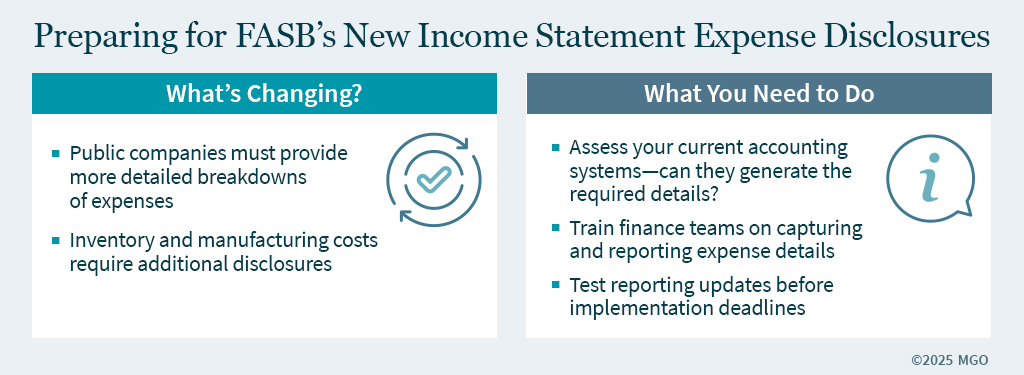Key Takeaways:
- A new Accounting Standards Update requires public companies to provide more detailed expense disclosures in their financial statements.
- Implementing these changes may require modifications to the chart of accounts and adjustments to financial reporting systems.
- Companies should get a head start assessing whether current accounting systems can support the required disclosures and make necessary upgrades.
—
In response to persistent calls from investors for enhanced transparency in financial reporting, the Financial Accounting Standards Board (FASB) issued Accounting Standards Update (ASU) 2024-03, Income Statement – Reporting Comprehensive Income – Expense Disaggregation Disclosures (Subtopic 220-40): Disaggregation of Income Statement Expenses (DISE). This update introduces a new layer of financial statement disclosures, requiring companies to adjust how they collect and report financial data.
Subtopic 220-40’s New Disclosure Requirements
The finalized ASU requires public companies to provide additional details about specific expense categories in financial statement disclosures.
Currently, companies can consolidate several expense line items into broad categories on income statements. For example, line items like “cost of goods sold,” “cost of sales,” and “selling, general, and administrative expenses” can comprise various direct and indirect costs of producing and selling a company’s goods and services, as well as overhead and administrative costs unrelated to production and sales. This lack of transparency makes it harder for investors, lenders, and other financial statement users to assess the company’s performance.
Subtopic 220-40 requires organizations to disclose (in a tabular format) amounts recognized in each of the following relevant expense captions:
- Purchases of inventory using the expense or cost-incurred approach
- Employee compensation
- Depreciation
- Intangible asset amortization
- Depreciation, depletion, and amortization (DD&A) recognized from oil and gas-producing activities
In addition, companies must provide additional details about inventory and manufacturing expenses, including:
- Inventory purchased
- Employee compensation related to manufacturing
- Depreciation and amortization of manufacturing assets
- Costs capitalized to inventory and manufacturing expenses
- Changes in inventory balances
- Other items used to reconcile costs incurred to expenses recognized
- How the company defines “other manufacturing expenses”
Practical Implications for Public Companies
At first glance, providing more details on expenses might seem simple. However, implementing these changes can become complicated quickly. You may need to reconsider how you categorize expenses, modify your chart of accounts, and evaluate whether your financial systems can extract and present the necessary information.
Some considerations include:
- Accounting system capabilities: Your current systems may not be configured to capture expense details at the required level of granularity. Evaluate whether your general ledger software and reporting tools can generate the necessary disclosures or if they’ll need modifications.
- Adjustments to reporting packages: Review whether your existing financial reporting packages can accommodate these new requirements.
- Audit readiness: The enhanced level of detail required in financial disclosures means auditors will focus on total expense amounts and how those expenses are disaggregated. Make sure you allow enough time to align your internal reporting with the new requirements so your internal and external audits will go smoothly.
- Training and internal processes: Team members responsible for financial reporting will need training on new data collection and reporting processes.
- Industry-specific considerations: The requirements apply broadly to all public companies, but the impact varies by industry. Your company should analyze which line items are relevant to your operations and adjust reporting accordingly.

ASU 2024-03’s Scope and Effective Date
The updated requirements apply to all public companies, although some expense categories may not be relevant depending on your industry. ASU 2024-03 is effective for fiscal years beginning after December 15, 2026, and interim periods beginning after December 15, 2027. Early adoption is permitted.
Because the new disclosures are required for annual and interim reporting periods, you cannot simply address these disclosures at year-end. You need to ensure your accounting systems can support the level of detail required for these disclosures throughout the year.
Preparing for Implementation
Adapting to the new reporting standards requires advance planning and preparation. Begin by conducting a gap analysis to determine whether your current financial systems can support the new disclosures. Reach out to your IT team and other advisors as soon as possible if you need modifications to facilitate a seamless transition.
Other steps you may need to take include:
- Review the detailed FASB guidance to determine the specific disclosures required.
- Assess internal data collection processes to make sure you’re capturing all necessary expense details.
- Engage with internal and external auditors to discuss expectations and potential challenges.
- Test reporting changes in advance to identify and resolve issues before compliance deadlines.
- Monitor ongoing compliance to ensure you’re prepared to meet interim reporting obligations.
How MGO Can Help
The changes introduced by the FASB’s finalized ASU will improve financial statement transparency, but they also present challenges for companies that are unprepared. Begin your implementation efforts now with planning, system updates, training, and allowing time to make adjustments and avoid last-minute compliance struggles. By proactively addressing these changes, you can minimize disruptions and keep your financial statements clear, accurate, and compliant.
If you have questions about Subtopic 220-40, contact us today to connect with professionals who can help.